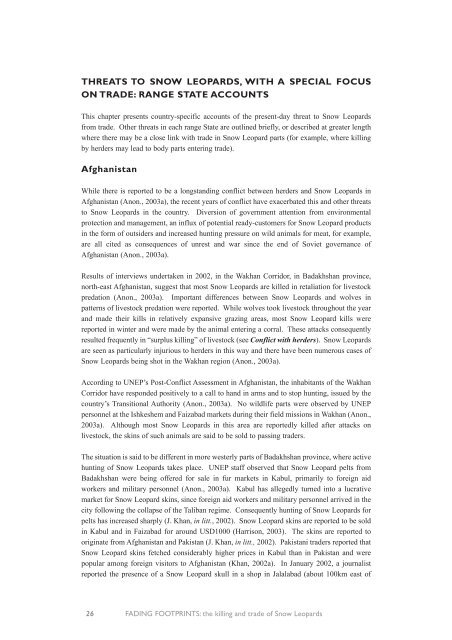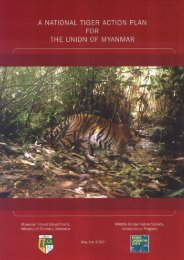Download - Global Tiger Initiative
Download - Global Tiger Initiative
Download - Global Tiger Initiative
Create successful ePaper yourself
Turn your PDF publications into a flip-book with our unique Google optimized e-Paper software.
THREATS TO SNOW LEOPARDS, WITH A SPECIAL FOCUS<br />
ON TRADE: RANGE STATE ACCOUNTS<br />
This chapter presents country-specific accounts of the present-day threat to Snow Leopards<br />
from trade. Other threats in each range State are outlined briefly, or described at greater length<br />
where there may be a close link with trade in Snow Leopard parts (for example, where killing<br />
by herders may lead to body parts entering trade).<br />
Afghanistan<br />
While there is reported to be a longstanding conflict between herders and Snow Leopards in<br />
Afghanistan (Anon., 2003a), the recent years of conflict have exacerbated this and other threats<br />
to Snow Leopards in the country. Diversion of government attention from environmental<br />
protection and management, an influx of potential ready-customers for Snow Leopard products<br />
in the form of outsiders and increased hunting pressure on wild animals for meat, for example,<br />
are all cited as consequences of unrest and war since the end of Soviet governance of<br />
Afghanistan (Anon., 2003a).<br />
Results of interviews undertaken in 2002, in the Wakhan Corridor, in Badakhshan province,<br />
north-east Afghanistan, suggest that most Snow Leopards are killed in retaliation for livestock<br />
predation (Anon., 2003a). Important differences between Snow Leopards and wolves in<br />
patterns of livestock predation were reported. While wolves took livestock throughout the year<br />
and made their kills in relatively expansive grazing areas, most Snow Leopard kills were<br />
reported in winter and were made by the animal entering a corral. These attacks consequently<br />
resulted frequently in “surplus killing” of livestock (see Conflict with herders). Snow Leopards<br />
are seen as particularly injurious to herders in this way and there have been numerous cases of<br />
Snow Leopards being shot in the Wakhan region (Anon., 2003a).<br />
According to UNEP’s Post-Conflict Assessment in Afghanistan, the inhabitants of the Wakhan<br />
Corridor have responded positively to a call to hand in arms and to stop hunting, issued by the<br />
country’s Transitional Authority (Anon., 2003a). No wildlife parts were observed by UNEP<br />
personnel at the Ishkeshem and Faizabad markets during their field missions in Wakhan (Anon.,<br />
2003a). Although most Snow Leopards in this area are reportedly killed after attacks on<br />
livestock, the skins of such animals are said to be sold to passing traders.<br />
The situation is said to be different in more westerly parts of Badakhshan province, where active<br />
hunting of Snow Leopards takes place. UNEP staff observed that Snow Leopard pelts from<br />
Badakhshan were being offered for sale in fur markets in Kabul, primarily to foreign aid<br />
workers and military personnel (Anon., 2003a). Kabul has allegedly turned into a lucrative<br />
market for Snow Leopard skins, since foreign aid workers and military personnel arrived in the<br />
city following the collapse of the Taliban regime. Consequently hunting of Snow Leopards for<br />
pelts has increased sharply (J. Khan, in litt., 2002). Snow Leopard skins are reported to be sold<br />
in Kabul and in Faizabad for around USD1000 (Harrison, 2003). The skins are reported to<br />
originate from Afghanistan and Pakistan (J. Khan, in litt., 2002). Pakistani traders reported that<br />
Snow Leopard skins fetched considerably higher prices in Kabul than in Pakistan and were<br />
popular among foreign visitors to Afghanistan (Khan, 2002a). In January 2002, a journalist<br />
reported the presence of a Snow Leopard skull in a shop in Jalalabad (about 100km east of<br />
26 FADING FOOTPRINTS: the killing and trade of Snow Leopards

















